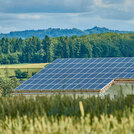
Quality pollinator habitat can be created beneath solar arrays. In an Oregon experiment, researchers found that pollinator abundance, diversity, and richness as well as pollinator-flower visitation rates were similar in plots in full sun (without solar arrays) and those in partial shade (under solar arrays). Areas of partial shade under the arrays had increased floral abundance and delayed bloom timing, which could support late-season foragers in water-limited ecosystems.
Graham, Maggie, Serkan Ates, Andony P. Melathopoulos, Andrew R. Molkdenke, Sandra J. DeBano, Lincoln R. Best, and Chad W. Higgins. “Partial shading by solar panels delays bloom, increases floral abundance during the late-season for pollinators in a dryland, agrivoltaic ecosystem”. Scientific Reports 11, 7452 (2021). https://doi.org/10.1038/s41598-021-86756-4.
